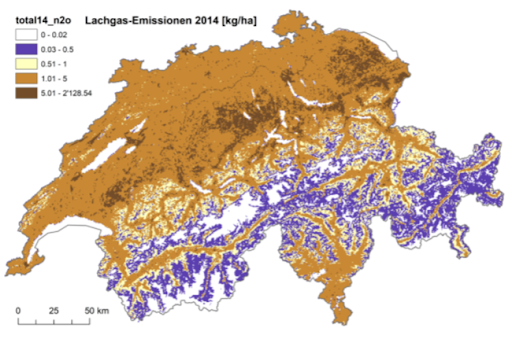New steps towards a model-based estimation of N2O emissions from agricultural soils in Switzerland
The agriculture sector is responsible for almost 13 per cent of all emissions in the Swiss GHG-inventory, with a significant contribution of N2O-emissions from agricultural soils. While the extent of the individual nitrogen pools can be estimated with acceptable precision, the amount of nitrogen converted to N2O, i.e. the emission factor, remains highly uncertain due to the very dynamic nature of soil processes that lead to N2O production.
So far default emission factors have been used in the Swiss inventory which may be adequate for average emissions integrated over large areas and a long time period. However, for a more detailed assessment of soil-borne emissions that depict regional and temporal heterogeneity a more sophisticated approach is needed.
Because of the complexity and the need of detailed databases covering the whole territory of a country, including reliable weather and farming data, so far only few countries have been able to use modelling for their N2O-inventories of the agricultural sector (e.g., China, Japan and the USA).
At Agroscope, the Swiss centre of excellence for agricultural research, a project was started in 2020 to evaluate process-oriented models for estimating soil-based N2O emissions under cropland and permanent grassland in Switzerland. The performance of the model DayCent, which has been successfully applied for national greenhouse gas (GHG) reporting in the US, is being tested for Swiss conditions.
DayCent is a model of intermediate complexity and is based on the CENTURY model that was broadly used to simulate soil organic matter (SOM) dynamics. In collaboration with researchers from different institutions and countries, including ETH Zurich (Switzerland), University College Dublin (Ireland), and Colorado State University (US) we are testing the model’s performance against measured data from long term field experiments. For parametrization and validation of specific processes and relationships additional field measurements are planned.
Our ultimate goal is to develop a model-based Tier 3 N2O inventory for national GHG reporting under the UNFCCC. Furthermore, a well-calibrated and evaluated model can also be employed to predict the impact of mitigation-practices at the country level (simulation of scenarios) and to guide locally adapted agricultural management.
This can support policies to curb agricultural GHG emissions. These shall be reduced to at least one third until 2050 compared to 1990 according to the climate strategy of the Swiss federal office for agriculture.
The project is funded by the Swiss Federal Office for the Environment.
Further information available at: [email protected]

